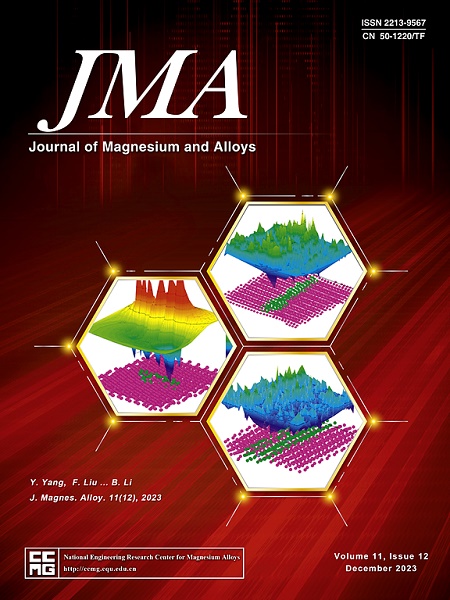Achieving ultra-high strength and ductility in a rare-earth-free magnesium alloy via precisely controlled secondary hot extrusion process with an extremely low extrusion speed
IF 15.8
1区 材料科学
Q1 METALLURGY & METALLURGICAL ENGINEERING
引用次数: 0
Abstract
Magnesium (Mg) alloys, as the lightest structural metallic materials, hold significant potential for various applications in modern society. However, their limited strength and ductility have restricted their widespread use. Herein, a precisely controlled secondary hot extrusion (SHE) process with extremely low extrusion speed (a cross-head rate of 0.1 mm·min−1) was employed to achieve ultra-fine microstructure with an average grain size of 0.45 µm and uniform precipitation of nano-sized Mn-rich secondary phase in a rare-earth (RE)-free Mg-1.5Ag-0.2Mn-0.1Ca (wt.%) (MACM) alloy. Nano-sized Mn-rich secondary phase with an average particle size of 2.7 nm could inhibit the basal slip and result in the simultaneous activation of multiple slip systems, contributing to excellent ductility. Additionally, substantial elemental segregation occurred at the grain boundaries of the α-Mg phase in the SHEed Mg-Ag-Mn-Ca alloy after tensile deformation, providing significant solute drag pressure and Zener pressure. This phenomenon induces grain boundary segregation strengthening and activates non-basal slip. Consequently, the secondary hot extruded (SHEed) alloy exhibited an ultra-high ultimate tensile strength (UTS) of ∼422 MPa, a yield strength (YS) of ∼362 MPa, and an excellent elongation of 30.0%. Quantitative analysis of strengthening behavior in the SHEed MACM alloys revealed that the primary strengthening mechanism is grain refinement, with consideration given to the influences of Orowan strengthening and work hardening. This study provides a novel approach to synchronously ameliorate the strength and ductility in Mg-based materials for load-bearing applications.

通过精确控制的二次热挤压工艺和极低的挤压速度,实现无稀土镁合金的超高强度和延展性
镁(Mg)合金作为最轻的金属结构材料,在现代社会的各种应用中具有巨大的潜力。然而,其有限的强度和延展性限制了其广泛应用。本文采用精确控制的二次热挤压(SHE)工艺,以极低的挤压速度(十字头速度为 0.1 mm-min)在不含稀土(RE)的 Mg-1.5Ag-0.2Mn-0.1Ca (wt.%) (MACM) 合金中实现了平均晶粒尺寸为 0.45 µm 的超细微观结构和纳米级富锰二次相的均匀沉淀。平均粒径为 2.7 纳米的纳米级富锰二次相可以抑制基底滑移,并同时激活多个滑移系统,从而产生优异的延展性。此外,拉伸变形后,SHEed Mg-Ag-Mn-Ca 合金中 α-Mg 相的晶界发生了大量元素偏析,提供了显著的溶质拖拽压力和齐纳压力。这种现象会诱发晶界偏析强化,并激活非基底滑移。因此,二次热挤压(SHEed)合金的极限拉伸强度(UTS)达到 422 兆帕(∼422 MPa),屈服强度(YS)达到 362 兆帕(∼362 MPa),伸长率达到 30.0%。对 SHEed MACM 合金强化行为的定量分析显示,主要强化机制是晶粒细化,同时考虑了奥罗旺强化和加工硬化的影响。这项研究为同步提高镁基材料的强度和延展性提供了一种新方法,可用于承重应用。
本文章由计算机程序翻译,如有差异,请以英文原文为准。
求助全文
约1分钟内获得全文
求助全文
来源期刊

Journal of Magnesium and Alloys
Engineering-Mechanics of Materials
CiteScore
20.20
自引率
14.80%
发文量
52
审稿时长
59 days
期刊介绍:
The Journal of Magnesium and Alloys serves as a global platform for both theoretical and experimental studies in magnesium science and engineering. It welcomes submissions investigating various scientific and engineering factors impacting the metallurgy, processing, microstructure, properties, and applications of magnesium and alloys. The journal covers all aspects of magnesium and alloy research, including raw materials, alloy casting, extrusion and deformation, corrosion and surface treatment, joining and machining, simulation and modeling, microstructure evolution and mechanical properties, new alloy development, magnesium-based composites, bio-materials and energy materials, applications, and recycling.
 求助内容:
求助内容: 应助结果提醒方式:
应助结果提醒方式:


